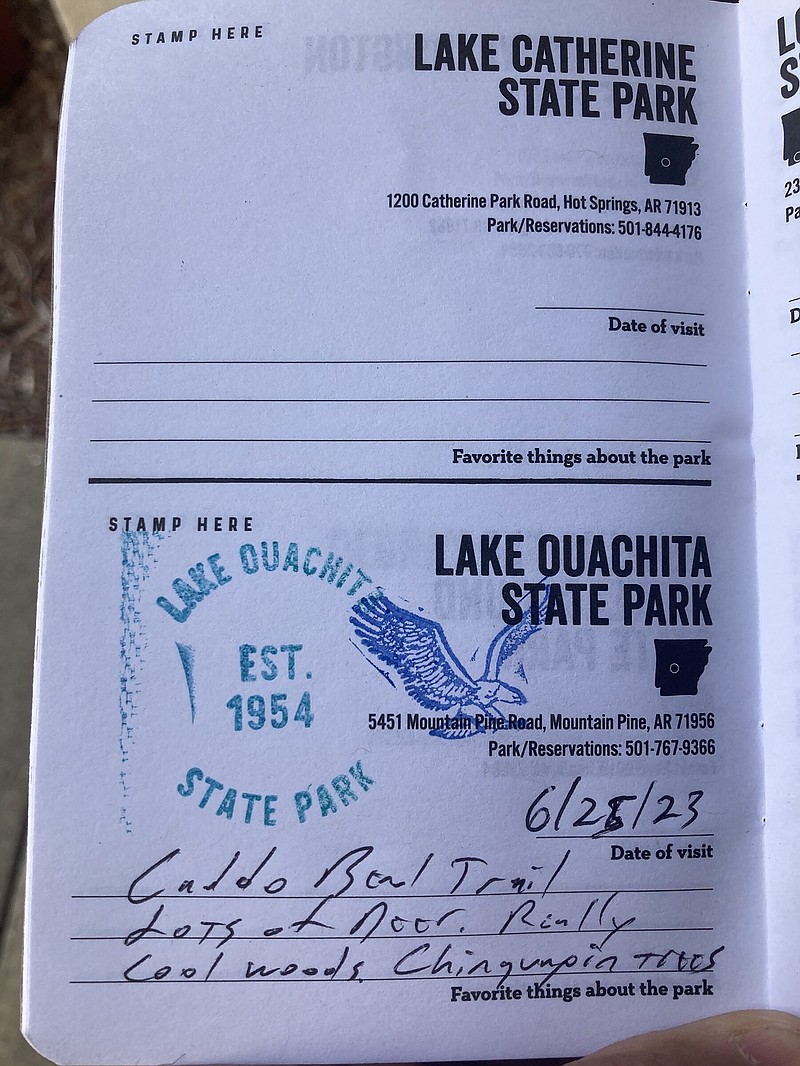MOUNTAIN PINE -- Lake Ouachita State Park gets lost among the many world-class recreation options in the Diamond Lakes area, but it is well worth visiting.
My adventuring partner and I visited Lake Ouachita State Park on Sunday in our quest to visit all 52 Arkansas state parks in one year. We temporarily suspended our tour of Northeast Arkansas for a day in the Ouachita Mountains. We were not disappointed.
Tucked among the mountains northwest of Hot Springs, Lake Ouachita State Park occupies a long peninsula bracketed by two long, deep coves. A verdant forest of mature hardwoods and pines blankets the steep, rugged, rocky terrain. It is old growth forest containing many species of red oaks, white oaks, hickory, and even some beech and wild cherry.
State park staff is even attempting to restore chinquapin, a close relative of the American chestnut. The chinquapin was once vital to mountain life in Arkansas. Its wood was resistant to decay, making it highly prized for making fence posts and furniture. I have a chinquapin turkey call made by Bill Rhodes of Sheridan. It is a prized possession.
As with the American chestnut in the Appalchians, chinquapin nuts were staples for people in this hardscrabble country, as well as for wildlife and livestock.
As also with the American chestnut, a blight obliterated the chinquapin early in the 20th century. Trees get large enough to produce nuts, so new trees do sprout. New chinquapins also emerge from root runners, but blight gets most of them before they attain any size.
There still are some unblighted chinquapins in Arkansas, mostly on remote, inaccessible slopes on Mount Magazine. These are grand, mature trees.
At Lake Ouachita State Park, we visited with a young man representing the American Conservation Experience. He was watering chinquapin saplings with a clever method that employs plastic milk jugs. The jugs contain water from Three Sisters Spring, which are also on the state park near the second swimming area. A small hole is drilled into the bottom of the jug, which is placed beside the tree and hydrates the roots by gravity.
Thin plastic tubes enshroud the trees. The tube protects the delicate trunks of the young trees from deer and other creatures that might damage the bark. When the trunk diameter exceeds the shroud's ability to contain it, the shroud breaks away and leaves the tree free to grow.
The employee told us this particular project started with 10 chinquapins. Seven survive and are doing well so far, he said.
Of course, 40,000-acre Lake Ouachita is the park's centerpiece. The water here is very clear and clean, making it ideal for every kind of aquatic recreation. The state park operates a marina where you can rent kayaks, paddleboards, pedal boats, jet-powered waterbikes, 16-foot fishing boats, an 18-foot ski boat and party barges. There are 70 covered and uncovered boat slips for rent, as well as mooring buoys away from the docks.
Bait, tackle, snacks and drinks are available in the marina shop. Even though we have enough tackle to last several lifetimes, we could not resist inspecting the inventory.
"This is like being a kid being in a toy for you, isn't it" my companion asked. "I look at this stuff and I'm like, 'Well, OK.' But then I look at you, and you're, like, in a dream world."
Busted!
Camping for all tastes is abundant. Currently, 93 campsites are available. Fifty-eight AAA sites have full utilities. There are 23 Class D sites and 12 walk-in tent sites. Eight fully equipped cabins and four "camper cabins" offer a deluxe visitor experience.
Three Sisters Spring is a delightful attraction. As its name suggests, it contains three distinct springs that once supported a thriving resort community. Promoters advertised that the mineral waters of each spring conveyed distinct medicinal benefits. They are listed on metal plaques over each spring. Dropsy, or edema, is one ailment that one of the springs is supposed to cure. Another spring supposedly cures constipation and pus in the kidney.
It's a good thing we experienced none of these ailments because a sign says the spring water does not meet safety standards and is considered to be non-potable.
As is our custom, we hiked a trail in the park. We chose the four-mile Caddo Bend Trail, the park's premier trail. It traverses the entire peninsula, taking you through a splendid forest that shows the wonderful effects of frequent doses of prescribed burning. The forest floor is open, allowing generous sight lines in every direction. Songbirds are plentiful and loud. I could have added three to my life list had I carried a bird identification guide. We saw six deer and many squirrels.
Though beautiful and pleasant, the Caddo Bend Trail is very steep and rocky in stretches. In Sunday's 100-degree heat and high humidity, it was challenging. Take plenty of water, and do take a long swim break at or near the midway point.
At the end of our hike, we enjoyed a light lunch at one of the picnic tables overlooking the marina and the first swim beach. We greatly appreciated an inexplicable lack of flies, and we were amused at two crows that perched on a limb above us waiting for us to leave our food unattended.
At the table beside us, a woman enjoyed a repast with her two young sons. She gave them a stern lecture about having to eat their sandwiches before getting their dessert. She refused to budge or negotiate, which prompted accusations of unfairness from her sons.
"No, sir," the mother rebutted. "That is the definition of fair!"
The younger boy relented, but he was crafty. Whenever his mom looked at him, he pretended to take a bite of his sandwich. When she looked away, he peeled off a bit at a time and flung it on the ground. The crows swooped down and disposed of the evidence.
He got his dessert. The older boy did not.

